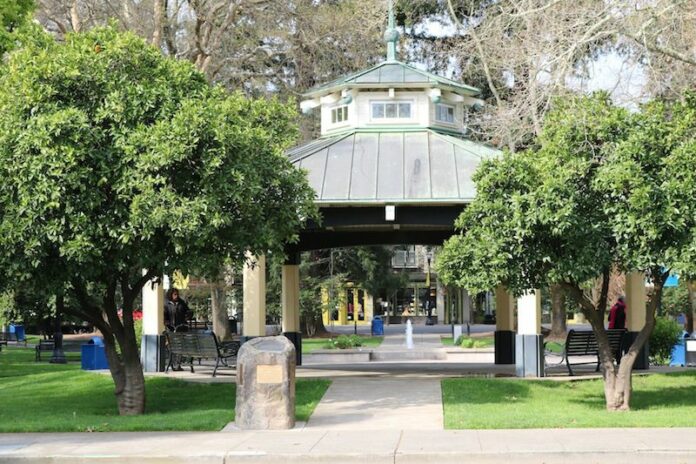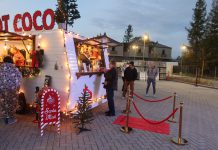After years of planning and community member collaboration and conversation, the Healdsburg Arts and Culture Master Plan has finally been approved and adopted.
On Aug. 16, the Healdsburg City Council unanimously approved the adoption of the arts and culture master plan, a project that’s been in the works for the last few years and has been delayed by fires and the COVID-19 pandemic.
The overarching goal of the plan is to guide the community in enhancing arts, culture and creativity in Healdsburg.
“Arts and culture have always been an important part of Healdsburg long before we started talking about an arts and culture master plan. There’s incredible artists, nonprofit organizations, creative individuals and businesses and lots of creative art energy here in Healdsburg, but what our department was hearing back in 2015 through 2017, was while there was all of this energy there wasn’t a factor bringing everything together to move arts and culture forward,” said Dave Jahns, recreation manager for the City of Healdsburg Community Services Department. “There was an opportunity where we could enhance that within our community.”
The final Healdsburg Arts and Culture Master Plan is organized into five goals, each with corresponding strategies and actions. The actions are planned for staggered implementation.
In part, the strategies and actions are:
Goal 1 – Build the structural foundation for arts and culture.
Strategies and actions:
Formally adopt a plan by the city council, create an arts and cultural commission, provide city staffing to achieve plan goals and provide financial support for plan implementation.
Goal 2 – Enrich cultural experiences for our community and our visitors.
Strategies and actions:
Identify and develop distinctive cross-sector collaborations for arts and culture experiences throughout Healdsburg, connect Healdsburg sector experiences, work with local hoteliers and tourism professionals in the creation of authentic and unexpected arts and culture experiences. Expand the visitor experience to be more local and year-round, articulate arts and culture as an important part of Healdsburg’s character of place by working with the chamber of commerce to designate a seat on the chamber board for an arts and culture representative.
Identify partnerships with chamber members and business community leaders, build on current programming and facilitate small-scale arts events and activities throughout the year.
Goal 3 – Foster and grow an inclusive creative economy.
Strategies and actions:
Facilitate economic growth of the creative sector by convening a diverse group of galleries, artists and other sectors. Cultivate the next generation of artists, creatives and art consumers by convening young artists, youth-focused community organizations and develop an arts and culture mentor and apprentice program with schools. Additionally, support the development of affordable work/live spaces for artists and enrich cultural experiences for both residents and visitors.
Goal 4 – Advance art in the public realm.
Strategies and actions:
Expand the current city public art program and align with national best practices by adopting percent-for-art-ordinance or resolutions and work with the arts and cultural commission to establish specific processes and guidelines for the selection of artists for public art projects.
Cultivate an advanced partnership with the Voigt Foundation and other partners on permanent and temporary projects. Create a street artist program and consider a signature festival — that could involve visual arts, performing arts, music and the literary arts — celebrating the character of Healdsburg.
Goal 5 – Advance development of arts and cultural spaces.
Strategies and actions:
Create a network of multiple, interconnected arts venues, facilities and cultural districts by building on the creative experiences and community collaborations happening at the Healdsburg Community Center. Working with Corazón and other community groups to envision a hatchery concept for youth artists and explore opportunities for an incubator or maker space.
Conduct a feasibility study for cultural facilities and spaces and explore the development of an artists’ work-live space.
The road to the plan
In 2017, the community services department and the Healdsburg Center for the Arts convened a community meeting at the Healdsburg Community Center to discuss with residents what they’d like to see in the city’s arts and culture scene, what could be improved upon and what works.
“We started off with community engagement by bringing a team on the ground,” Jahns said during the city council presentation.
This team is made up of 34 different community members, residents, artists, educators and other people with ties to the arts.
“They made sure this process was reflective of the Healdsburg community,” Jahns said.
In 2018, the Healdsburg Parks and Recreation Commission set a goal to engage the community in defining the role of the arts in the community. Later that year and in 2019, the city council established a goal that called for the city to embark on a community-based arts and culture master plan that would gather widespread input about the role of arts and culture in the city.
Community services would then use the information gathered to enhance the city’s participation in expanding the arts.
In the summer of 2019, the creative leadership team hired a professional consultant to help with the planning process and the community engagement process.
The process for creating the arts and culture master plan included conducting research and analyzing current arts and culture conditions, determining creative sector arts and culture priorities and community priorities and creating a vision for arts and culture in Healdsburg with specific goals, strategies and outcomes.
To do this, several resident engagement activities were held both virtually and in-person. The most recent community conversions were held in March 2021. Across the week of March 9, there were four community conversations, one in Spanish, two in English and one for kids in grades 3 to 12.
A community survey was also conducted. In total, over the course of almost three years, there were 14 creative leadership team meetings, five in-person site visits and 45 meetings and stakeholder interviews with over 100 community members.
The plan was then drafted in April and May of this year and in June the parks and recreation commission reviewed the plan.
“This has been a long road, but we have thoroughly enjoyed the process,” said Linda Flynn, one of the team consultants who helped with the planning process.
After the plan was presented to the city council on Monday, there were a few public comments and comments from city council members
“Our Latin American neighbors are going to be the majority in this county and in this state and in this country in about 20 to 25 years … Our school district is already 70% Latin American. Despite the efforts and goodwill of the city staff, there is a lot more work to be done to make sure our arts and culture reflect the Latin American community. From the consultants who were hired, to those at the center of the decision making process, Latin Americans were not well enough represented,” said Glaydon de Freitas, the CEO of Corazón Healdsburg. “Our community wants to be the protagonist of their own future. We’re not the minority, we are the community, and we belong here. Having said that, we would like to suggest the implementation of the plan is largely conducted in conjunction with Latin American leaders and second, that this council obligates the city to contract with consulting firms owned or led by brown, Indigenous and people of color. This is not an actionary or revolutionary demand, it is just a mandatory requisite of the most important element of democracy, representation.”
Councilmember Skylaer Palacios said she thinks the plan is broad and inclusive in terms of its goals, but echoed de Freitas’ comments.
“I do see that there was a good effort to include youth and Latino people in the planning process and I do appreciate Glaydon’s comments as well and then to just echo that, myself and Councilmember (Ariel) Kelley did have a meeting with some Indigenous members of our community and we talked with staff and we realized that their voice was not represented in this process, so just moving forward, I definitely want to express the need to include their voices in the planning process moving forward,” Palacios said.
Kelley said there was a missed opportunity to engage with the Indigenous community on the plan. However, she said the plan is thorough and colorful and has a lot of great data.
Councilmember David Hagele was excited to see the completion of the plan and offered the motion to adopt the plan.
Next steps
Community outreach and engagement will be conducted with community partners for the implementation of the plan. Implementation workshops will be held this fall and plan implementation will commence in the fall and winter, 2021-22.
“This is a phased plan. It will take five to 10 years to accomplish these goals,” Jahns said.
In the spring of 2022, the city council will consider future funding for the plan’s actions.








